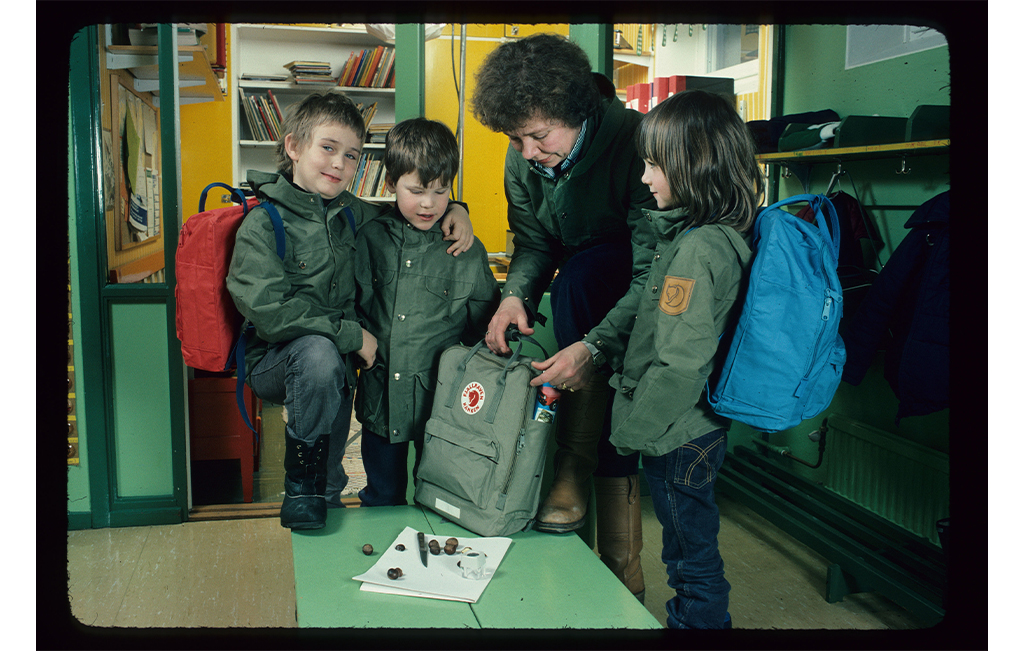Editor’s note: This article is a part of the Heritage content series, sponsored by Fjällräven.
As it turns out, bigger isn’t always better—especially when it comes to backpacks. A bigger load can result in a heavier one that leaves you aching after just a few steps. So when Fjällräven founder Åke Nordin decided to design a bookbag for schoolchildren, he made something so small and unassuming that it hardly looked likely to become the iconic backpack it is today.
It was the Kånken, named after the Swedish word kånka, meaning to lug something around. And in 1978, when Nordin hatched his idea for a children’s school pack, Swedes were fed up with load-lugging.
Back then, Swedish kids typically carried their books in messenger bags that weighted one shoulder only. “Backpacks did exist,” but only hikers used them, explains Henrik Andersson, head of innovation and design at Fjällräven (pronounced “fyell reven”), a Swedish company with North American headquarters in Louisville, Colorado. Backpacks weren’t trendy among school-goers or commuters, he says.
As a hiker, Nordin knew that a well-designed backpack could haul stuff without causing the kind of back pain that Sweden’s citizens were experiencing. After all, he’d launched Fjällräven in 1960 with a simple, aluminum-frame hiking pack. After reading a newspaper article reporting 80 percent of Swedish adults and children admitted to experiencing back pain from using shoulder bags, Nordin hatched his solution: a backcountry backpack for use at school and around town.

Photo courtesy of Fjällräven.
Then and now, Swedish kids didn’t always stick to paved sidewalks. The country’s tradition of skogsmulle—an outdoor preschool with a nature-based curriculum—encouraged Swedish youth to play outside. Consequently, Nordin designed his Kånken with a removable foam back panel cushion that doubled as a comfy seat when the child sat in the woods or on a wet bus stop bench.
That removable foam pad was the Kånken’s standout feature. Beyond that, the pack’s appearance was plain: it included just one pocket—a roomy exterior pouch with a zipper, two webbing shoulder straps and a carrying handle. The square shape mimicked that of the three-ring binders that kids typically carried. With limited capacity, there was only enough room for just two binders, plus maybe a book or a jacket. The backpack’s modest capacity compelled the wearer to bring only what they truly needed.
Perhaps because the backpack lacked a distinct personality, it let Swedes embrace it as their own. By 1980, after just two years on the market, more than 30,000 Kånkens had been sold. Skogsmulle children adopted them, and students found them to be much more comfortable than messenger totes and more practical for bicycle commuting.

Photo courtesy of Fjällräven.
As a model of Scandinavian efficiency and practicality, this humble backpack became a beloved Swedish icon.
In 2008, Fjällräven refreshed the Kånken by releasing it in a dazzling array of colors that offered more pop and pizazz than the basic reds, greens and blues that had made it a classic. The expanded palette broadened the pack’s global appeal and attracted devotees in Japan, the U.S. and South Korea (where a popular boy band embraced it and spiked demand, the brand says).
Over four decades, the Kånken’s design has remained largely unchanged, though the line now includes mini versions for toddlers, laptop-carriers for techies and a version made of plastic bottles.
And its original emphasis on efficiency and longevity seems even more relevant now, as people around the world look for ways to live and shop more sustainably. The pack’s square shape reduces fabric waste during production, Andersson explains, because “cutting a lot of round shapes into square-edged sheets of fabric creates a lot of scraps.” And the same water-resistant material (called vinylon) that was chosen for the very first Kånkens still handles rain today without the need for chemical water-repellent coatings; it feels like waxed cotton, but the fabric is made up of synthetic fibers that swell when wet, making the weave tighter.
Part of the backpack’s appeal, then and now, is its durability. Hand-me-down Kånkens remain in service long beyond their original purchase date. And many owners elect to hold onto them and keep using them through several phases of life.
For some, that’s an environmental choice. Consumers increasingly understand that discarding gear has negative environmental impacts, while keeping it in use is the more sustainable option. That’s why the co-op and other major retailers now urge manufacturers to make gear that lasts.
For many Kånken owners, the pack starts to feel like an old friend that’s worth keeping. “That’s our ambition,” says Andersson. “We want to create a bond, an emotional attachment to a product that ages nicely.”
